Back by popular demand—or force of habit—it’s time for the annual preseason College Football’s Most Intriguing lists. Last week we went over the coaches. This week: Most Intriguing Quarterbacks. Let’s dive in:
1. Caleb Williams, USC
The man with the profane manicures and all the dazzling pocket moves is on his way to being the No. 1 draft pick next spring. Every college QB since Trevor Lawrence went pro has engendered some nagging doubt in NFL scouts—Williams, not so much. Last year’s Heisman Trophy winner is widely viewed as one of the surest bets in years for pro stardom. But before getting to the draft, he has another chance to further elevate the Trojans after teaming with Lincoln Riley to take them from 4–8 to 11–3 in his first season in Los Angeles, producing 52 total touchdowns along the way. Williams’s improvisational flair makes him the most entertaining player in college football.
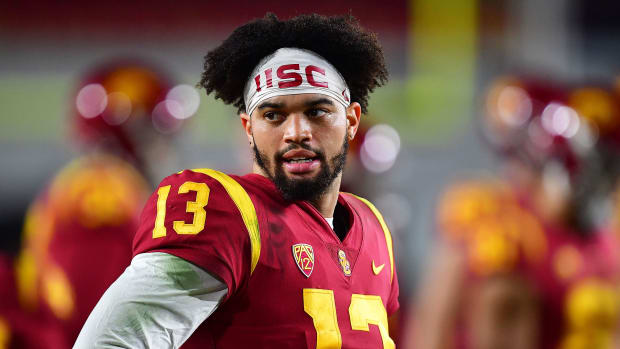
Gary A. Vasquez/USA TODAY Sports
2. Drake Maye, North Carolina
If Maye weren’t in the same draft-eligible class as Williams, he’d be viewed as the slam-dunk first pick. As it is, he’s Williams’s dazzling dual-threat counterpart on the opposite coast, amassing more than 5,000 yards total offense and 45 TDs in his first season of extensive college action. Passing or running, he is fluidity in motion. The Carolina blue runs deep, with father Mark a former UNC quarterback, brother Luke a former Tar Heels basketball player and younger brother Beau currently on the UNC hoops team. With Maye at the controls, is this 71-year-old Mack Brown’s last great chance to have a great team?
3. Quinn Ewers, Texas
There has been a lot written and said about a guy with 10 career college starts. He was a hotshot Texas commit who de-committed, graduated high school early, enrolled at Ohio State as a first-year NIL baby, played two snaps, transferred to Texas, became the starter, got hurt, returned to the lineup and was generally more renowned for his mullet than his production. Since then, Ewers has cut the mullet, beaten out megarecruit Arch Manning and others to keep his job and reportedly has worked diligently to become the star QB he was billed to be. A season of high expectations on the Forty Acres starts with Ewers as the Longhorns’ central character.
4. Sam Hartman, Notre Dame
The rib he had surgically removed to prevent blood clotting is being made into a necklace, which in and of itself is worth top-five status on this list. But there is plenty of additional intrigue with Hartman, a sixth-year player who threw for 94 touchdowns and nearly 11,000 yards at Wake Forest. Hartman is trying to prove his skills translate outside the esoteric Dave Clawson offense, keying an offensive reboot in South Bend. There is a new coordinator (Gerad Parker) and plenty of skill-position churn, with Hartman being counted on to lead the new-look Fighting Irish to more productivity than last year.
5. Shedeur Sanders, Colorado
Nepo baby or rising star? The son of the No. 1 guy on the Most Intriguing Coaches list is part of the purported Louis Vuitton talent infusion in Boulder. Sanders has a lot on his shoulders, arriving from FCS Jackson State and jumping into the power-conference fray. Having thrown for nearly 7,000 yards and 70 touchdowns in two seasons playing for his pops, Shedeur is now the centerpiece of dad Deion’s much-anticipated makeover of Colorado football. With all eyes focused on the Buffaloes in opening games against TCU and Nebraska, Coach Prime and Little Prime will likely sink or swim together.
6. Unnamed Starters, Ohio State and Alabama
The two premier QB factories of the past few seasons have ongoing battles to decide who will start. The last four starters for both the Crimson Tide and Buckeyes were all Heisman finalists (albeit one of Alabama’s got there after transferring to Oklahoma). Six of the eight were top-15 draft picks. Now, after Bama’s Bryce Young and OSU’s C.J. Stroud went 1 and 2 in the draft, there are open competitions to fill big shoes at both powerhouses. The Tide has a three-way competition going between Jalen Milroe, Ty Simpson and Notre Dame transfer Tyler Buchner. The Buckeyes have a two-way battle between Kyle McCord and Devin Brown. No pressure, guys.
7. Drew Allar, Penn State
Sean Clifford was a solid starter for four seasons, but he suffered in comparison to the Ohio State gunslingers who beat him and the Nittany Lions every year. This season, dare to dream—does Penn State finally have a better quarterback than the nemesis Buckeyes? And maybe better than Michigan as well? Allar was a hyped recruit who showed flashes last year; now comes his star turn. This should be a balanced offense that doesn’t ask too much of Allar, but there will be a need to make winning plays in big games if Penn State is going to rise above third place in the Big Ten East.
8. DJ Uiagalelei, Oregon State
There are no direct routes from Clemson to Corvallis, which is fitting. From Trevor Lawrence’s heir apparent to “Fansville” commercial star to benched to the transfer portal, it has been an unexpectedly bumpy journey for DJ. There were flashes of brilliance at Clemson but also long stretches of struggles, with the struggles accompanied by strident debate over scheme and surrounding talent vs. Uiagalelei’s own shortcomings. The likable senior gets a fresh start in Corvallis with a talented team that is a dark-horse Pac-12 championship contender.
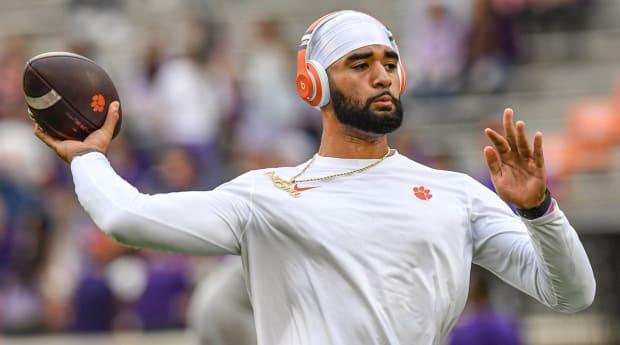
Ken Ruinard/USA Today Sports
9. J.J. McCarthy, Michigan
Rather startlingly, Jim Harbaugh has lit a bonfire of hype around his quarterback: “I have searched my memory for somebody who has been a first-time starter and had a better first year … and I can’t come up with one,” he said at Big Ten media days, overlooking Heisman Trophy winners Jameis Winston and Johnny Manziel, among others. McCarthy was good last season, ranking second in the Big Ten to C.J. Stroud in both pass efficiency and total offense yards per play. He also struggled to produce touchdowns in the red zone and threw two pick-sixes in the playoff upset loss to TCU. Michigan’s national title aspirations may well require McCarthy to become as good as his coach thinks he is.
10. Carson Beck, Georgia
The endless tenure of Stetson Bennett led to an extended apprenticeship for Beck, who hasn’t thrown a pass in a close game since arriving between the hedges in 2020. Now he’s tasked with leading a team in search of an unprecedented national championship three-peat. Beck is the starter for now, but Kirby Smart has had his share of in-season QB shuffles, and the Bulldogs’ backups are talented as well. This Georgia team appears to be so solid in so many areas that it might not need much in the way of heroic QB play to make a run at the title.
11. Cade Klubnik, Clemson
The Texan is still a teenager, but the 19-year-old Klubnik will be expected to perform as a fully mature starting quarterback in a retooled Tigers offense. Klubnik showed flashes of his potential as a freshman last year (ACC championship game), while also enduring some major growing pains (Orange Bowl). The early reviews of Klubnik’s performance in new coordinator Garrett Riley’s offense are promising, as Clemson looks to regain the elite quarterback play it enjoyed with Deshaun Watson and Trevor Lawrence. If Klubnik struggles, we’ll see whether Dabo Swinney supports him as fiercely as he did Uiagalelei the previous two years.
12. Michael Penix Jr., Washington
Caleb Williams deserved all the accolades he got, but he didn’t lead the nation—or even the Pac-12—in passing yards or total offense. That was Penix, the left-handed Indiana transfer who was reenergized under Huskies coach Kalen DeBoer. Penix, who finally played a full season after an injury-riddled four years with the Hoosiers, opted to return to Washington for a sixth year, and he has a lot of company. Penix’s potential checklist for the season: leading the best offense in the country, making a run at the Heisman, being the star of a playoff contender and improving his NFL draft stock all at the same time.
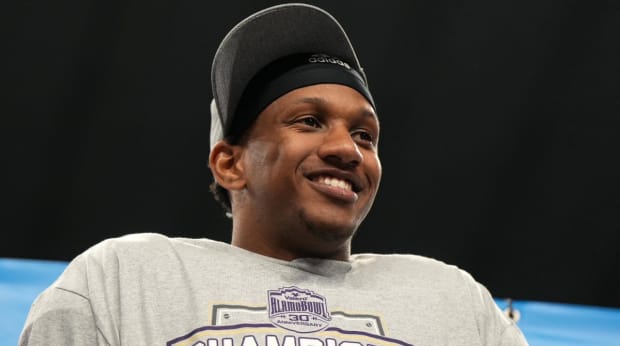
Kirby Lee/USA Today Sports
13. Cade McNamara, Iowa
The Michigan transfer merely has the employment of offensive coordinator (and coach’s son) Brian Ferentz in his hands. If McNamara performs well and gets the Hawkeyes in the end zone with some regularity, last year’s offensive debacle becomes a Spencer Petras blamefest. If McNamara performs poorly and Iowa again flounders when possessing the ball, it could finally cost Ferentz his job after years of enjoying familial privilege. McNamara will be hungry to prove his own worth, of course, after leading the Wolverines to the 2021 playoff and still losing his starting job to McCarthy. “I’d take 100 Cades on any team I’d coach,” said Michigan punter Brad Robbins when McNamara transferred last year.
14. Joe Milton, Tennessee
The 2020 season began with Milton in the Uncle Rico role, attempting to throw a football over them mountains on every drop-back as the Michigan starter. Accuracy was another matter, and things didn’t work out in Ann Arbor for Milton. Now after two years backing up Hendon Hooker, he’s the next transfer looking to have a breakout season on the way to the NFL in Josh Heupel’s hyperfast offense. Milton comes into the season having not thrown an interception since Nov. 14, 2020, a span of 19 games and 176 passes.
15. Tanner Mordecai, Wisconsin
Mordecai is one of the key transfers of 2023, arriving from SMU. The Badgers have finished in the bottom half of the Big Ten in passing yards for seven straight seasons, which is one of the reasons why Paul Chryst is no longer the coach, and veteran starter Graham Mertz is now at Florida. Luke Fickell is not exactly Mike Leach when it comes to chucking the ball around, but bringing in Mordecai was a signal that the plan is to modernize the Wisconsin offense. Mordecai has thrown for 76 career touchdowns and more than 7,700 yards, so he’s been around the block.
16. Jordan Travis, Florida State
If the Seminoles really are back as a playoff contender after a long hiatus, Travis is the guy leading them there. While Mike Norvell has been hyperactive in the transfer portal adding pieces the past two offseasons, the quarterback who has weathered many ups and downs in Tallahassee is the foundational continuity. He’s gotten better every season, with his 160.11 pass efficiency rating last year leading the ACC and his 8.35 yards per play of total offense ranking fourth nationally. Correspondingly, Florida State’s scoring has risen from 25.8 to 27.6 to 36.1 over the past three seasons.
17. Chandler Morris, TCU
Hard to believe now, but Heisman finalist Max Duggan was not the Horned Frogs’ season-opening starter last year—Morris was. He injured his knee in that first game against Colorado, and the rest was Wally Pipp history. While that could have been considered a preseason misevaluation by the TCU staff, Sonny Dykes has since said the competition wasn’t very close. Now Morris gets his shot to show what he can do in Dykes’s QB-friendly offense, working with new coordinator Kendal Briles. Morris had one spectacular game against a very good Baylor team in 2021, producing 531 yards of total offense and three touchdowns. If he can replicate that, look out.
18. Bo Nix, Oregon
There were two dramatic career reclamations in the Pacific Northwest last year—Michael Penix Jr. at Washington and Nix at Oregon. His boom-or-bust playmaking was exciting as a celebrated Auburn freshman but tiresome as a criticized junior, as the Tigers’ fortunes turned south. That necessitated a change of scenery, and Nix flourished with the Ducks. He was in the top 10 nationally in passing efficiency and top five in yards per play of total offense—still producing sizzle-reel plays in bulk while cutting down on the cringe plays. Nix fits right in with the rest of the QB talent in the Pac-12 this season, and the NFL will be watching his season closely.
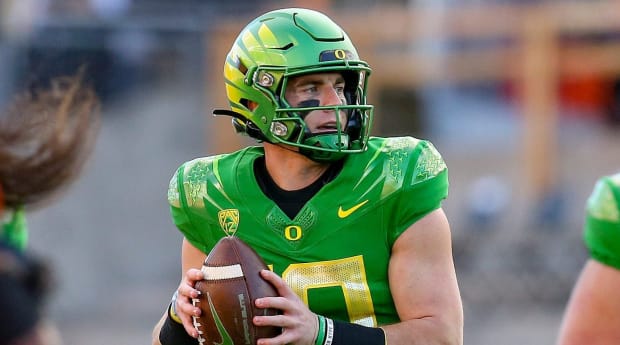
Ben Lonergan/USA Today Network
19. Michael Pratt, Tulane
The hype—Heisman and NFL draft versions—has been building over Pratt ever since he led two touchdown drives in the last 4½ minutes to upset USC in the Cotton Bowl. While the hub of that Green Wave offense was running back Tyjae Spears, Pratt showed his moxie and poise several times as the stakes rose during Tulane’s 12–2 dream season. Now, with Spears in the NFL, Pratt takes on a bigger role. As a three-year starter for the Wave, he’s thrown for more than 7,000 yards and rushed for more than 850 yards. Pratt is trying to prove that not all NFL QB prospects move on to Power 5 programs after showcasing what they can do.
20. Cameron Rising, Utah
The Utes’ “alpha dog,” in the words of coach Kyle Whittingham, is racing against the rehab clock to be ready for a huge season opener against Florida in Salt Lake City. In probably the saddest moment of the 2022 bowl season, Rising sustained a torn ACL against Penn State in the Rose Bowl last year, making this a tight turnaround to be ready. Regardless, he’s expected to play early this season, and his impact has been profound on the two-time Pac-12 champions. He’s thrown for more than 5,500 yards and run for more than 950 yards in his two years as the Utes’ starter, proving to be a brass-knuckles competitor in the Whittingham/Utah mold.
21. Grayson McCall, Coastal Carolina
The heart and soul of the upstart Chanticleers program ranks third in FBS history in career pass efficiency, trailing only Tua Tagovailoa and Mac Jones—and he’s thrown far more passes than both of them. His 207.6 efficiency rating in 2021 stands as the FBS record. McCall hit the transfer portal last year after former CCU coach, Jamey Chadwell, left, then decided to stick around for one more ride in teal. Will McCall still lead all QBs in eye black and mullet? We’ll find out soon. Regardless, he will depart Coastal as the most beloved player in school history.
22. Taulia Tagovailoa, Maryland
He’s not just Tua’s little brother anymore. Lia, as he’s known, will give J.J. McCarthy a run for top returning QB in the Big Ten. A midseason injury slowed him down for three games last year, but when healthy, Tagovailoa is good for 300 pass yards per outing. He’s led the Terrapins to their best two-season run since the Ralph Friedgen era, winning 15 games. But the question is whether Maryland can ever significantly improve its lot in the loaded Big Ten East. The Terps catch Penn State and Michigan in College Park at advantageous times; if Tagovailoa is healthy, can he make some magic happen?
23. Frank Harris, UTSA
This is the ultimate 2023 story, mixing realignment, NIL and bonus seasons—the only thing missing is a transfer. Harris, 24, is in his seventh year in college. Injuries, redshirts and COVID-19 have given him extra eligibility, and he opted not to transfer to a bigger program after a groundswell of NIL support kept him at the only college program he’s ever known. Harris has compiled more than 11,000 yards to total offense in leading the Roadrunners to Conference USA respectability, then C-USA supremacy and now American Athletic Conference membership. Keep an eye on Harris and UTSA in the AAC this year.
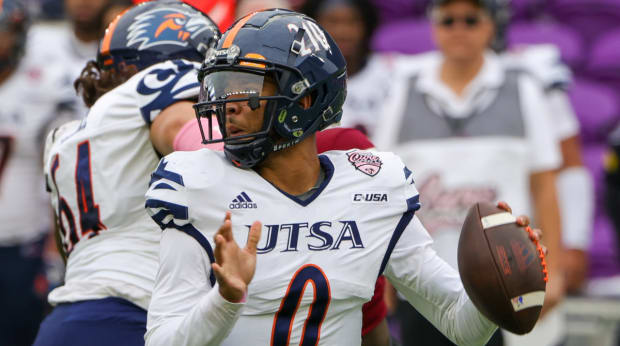
Mike Watters/USA TODAY Sports
24. Jayden Daniels, LSU
Daniels is arguably the biggest reason why Brian Kelly’s first season in Baton Rouge went so well. He arrived from Arizona State and provided a reliable, dual-threat dynamism, throwing for 2,913 yards and rushing for 885 yards. His overtime touchdown run and two-point conversion pass to beat Alabama earned him a place in LSU lore, but expectations are even greater for this season. If the Tigers are going to repeat in the SEC West and make a run at the Playoff, Daniels will be the driving force offensively.
25. Bryson Daily, Army
Why would an Army QB make this list? Because, in a startling break from tradition, the Cadets are actually endeavoring to throw the ball this year. The national leader in passing aversion has had a change of scheme, in part because new cut-blocking rules have scuttled some of the effectiveness of Army’s option attack. Thus the Cadets are entering a new era, with preseason practice video of passes filling the skies. Daily is atop the depth chart at the moment, and it may take him only a few weeks to throw for more yards than any Army QB has in a season in a long time.
Just missed the list
Graham Mertz, Florida; Kurtis Rourke, Ohio; Taylen Green, Boise State; all the quarterbacks at Mississippi; KJ Jefferson, Arkansas; Will Rogers, Mississippi State; Spencer Rattler, South Carolina; Tyler Van Dyke, Miami; Riley Leonard, Duke; Will Howard, Kansas State; Devin Leary, Kentucky; Jack Plummer, Louisville; Kedon Slovis, BYU; JT Daniels, Rice; Jalon Daniels, Kansas; Phil Jurkovec, Pittsburgh; Casey Thompson, Florida Atlantic; Dillon Gabriel, Oklahoma; Austin Reed, Western Kentucky.







